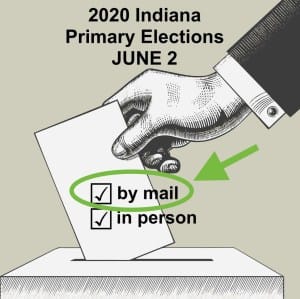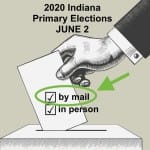Monroe County’s election board chair on June 2 primary: “We’ll continue to encourage voting by mail as much as we can.”



It’s possible that Indiana’s state election commission will make a decision at its April 22 meeting to eliminate in-person voting from this year’s primary election, now scheduled for June 2.
As they wait out the roughly three weeks until a possible state-level decision, Monroe County election officials are hoping that most voters will eventually take advantage of the vote-by-mail option, which already been made available to all voters for this year’s primary.
The date of the primary has already been delayed by four weeks, in a decision the state commission made last week.
The changes to the timing and manner of the primary elections in the Hoosier state are motivated by the COVID-19 pandemic that is spreading across the world. Reducing the opportunity for person-to-person transmission of the virus is a part of myriad protocols now in place across the state and locally.
The chance for all voters to send in a ballot by mail was established through an emergency order adopted by the state commission. Normally some “excuse” has to be given by a voter who wants to vote as an absentee through the mail. The commission’s March 25 emergency order allows for “no-excuse” absentee voting.
Local officials are keen to make sure voters, many of whom have never voted through the mail, understand how to get a ballot. At Thursday’s meeting of Monroe County’s board of elections, Carolyn VandeWiele, the Democratic Party’s representative on the three-member board, said voters need know where they are supposed to send their application for a ballot.
The application form, and the ways the application can be submitted are described on the Election Central website. Email, fax, and regular mail are among the options:
Email: election@co.monroe.in.us
Fax: (812-330-6460)
Mail: Voter Registration, 401 W 7th Street, Suite 100, Bloomington, IN 47404
Board chair Hal Turner, who’s the Republican Party’s representative on the board, said he is expecting to have “as normal a vote as possible, given the circumstances.” Turner’s expectation is based on the fact that the June 2 date comes a month after the now-extended deadline of Indiana governor Eric Holcomb’s order declaring a health emergency.
Still, Turner is pointing voters to the vote-by-mail option. “We’ll continue to encourage voting by mail as much as we can,” Turner said.
One normal activity, which is vital to the voting process, whether it’s conducted by mail only or partly in person, is the logic and accuracy test (LAT) for voting equipment.
The LAT was conducted at Election Central on Friday morning. Monroe County’s election supervisor, Karen Wheeler, told The Square Beacon that the test of the new Hart Intercivic equipment took a couple of hours.
The test was done on three scanners and one high-speed scanner by Bob White of B&L IT Services. The equipment achieved 100-percent accuracy on the test deck of ballots, Wheeler said. The report stated, “Test results are certified, correct and accurate.”
The LAT is open to the public, but the notice of the test suggested that people stand behind a roped off area inside the building or watch through the window from outside, in the interest of reducing the chance for COVID-19 infection. The Square Beacon’s photographic documentation of the event was shot through a window.
Specific concerns about in-person voting that were aired at Thursday’s board meeting include the difficulty in recruiting poll workers and concerns by polling place hosts about the possible spread of COVID-19 to their facilities.
Monroe County’s election supervisor, Karen Wheeler, reported at Thursday’s meeting that her staff had done initial recruitment of people to work the polls, but it was now in the hands of representatives from the two major political parties. She did not have a current update from those recruiters.
Turner drew out the fact that the pay for poll workers is approximately $125 for the day and can range up to $165. He suggested that workers who have been laid off recently, due to the pandemic’s impact on their employer, could be recruited to work the polls.
Wheeler said on Thursday that many of the polling location hosts are concerned about serving as a polling location. Churches, fire stations, and schools are not really sure that they want to move forward, Wheeler said. Meadowood Retirement Community, which serves as a polling location in the city of Bloomington, was highlighted by Wheeler as a specific concern.
Residents of long-term care facilities and retirement homes are at greater risk for COVID-19 infection, due to their age and likelihood of having other health conditions.
Consolidating polling locations is an option for local election boards to reduce the number of poll workers. Wheeler told The Square Beacon that the logistics of consolidating polling sites this late in the process would be a challenge.
Fewer locations to vote in person would increase the number of in-person voters, compared to more locations, so maintaining the required distances between people, given the nature of polling station work, would be more difficult, Wheeler said. She is hoping the state’s election commission will use its April 22 meeting to establish a mail-only election for the primary.
Polling locations for the general election in November also got some discussion at Thursday’s board of elections meeting.
Jerry Sanders, who’s superintendent at Richland Bean Blossom the Community School Corporation, and Dirk Ackerman, principle of Edgewood High School advocated at Thursday’s meeting for use of the Ellettsville town hall as a polling location instead of the high school.
Randy Paul, a disabilities advocate who’s collecting signatures to run as a Green Party candidate for county commissioner, weighed in on the question of using the school. Paul cited the accessibility requirements of the Help America Vote Act (HAVA), which echo the requirements of the Americans with Disabilities Act (ADA). One of the requirements is that parking places be within “a reasonable travel distance (200 feet maximum) from the building.”
The school did not comply, Paul said. He also said the Indiana Memorial Union building did not comply with the requirements of HAVA. When thinking about satisfying the distance requirements, Paul said, people should imagine a person who uses a walker who needs an oxygen tank.
The topic led to a chippy exchange between Paul and VandeWiele about the physical configuration of the IMU.
An outcome of the conversation about accessibility of polling places in Monroe County was a commitment from Turner to address the issue in the future. “We will re-address this issue of the accessibility of voting at all sites. And it will be a part of future agendas,” Turner said.





Comments ()